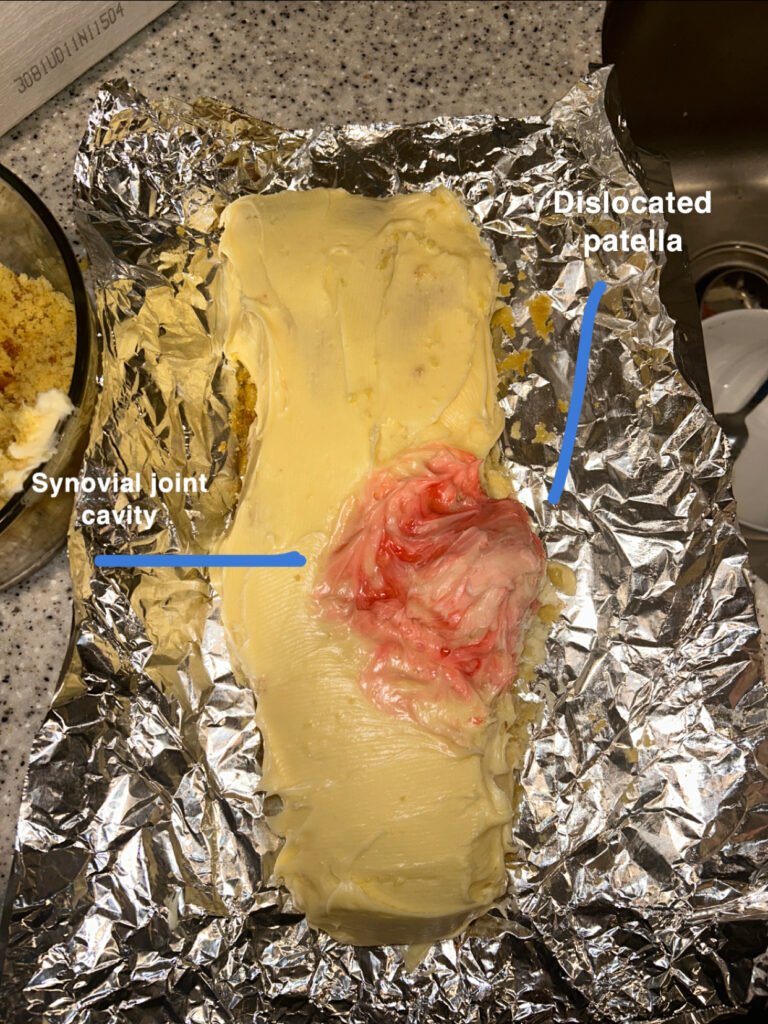
My art piece is on patellar dislocations and covers the structure of the knee joint that we
discussed in unit 4. When we learned about synovial joints in class, I was interested to learn
more about how the damage from a patellar dislocation affects the joint cavity. I baked a cake
and designed it to show the patella out of the joint socket, on the side of the joint. Patellar
dislocations often occur due to sports injuries, two thirds of all patellar dislocations occur in
active young people, under the age of twenty years old. Women tend to experience patellar
dislocations more frequently. Patellar dislocations occur due to a sudden sprain of the patellar
that tears the stabilizing structures. (Stefancin, Parker, 2007.)
The knee is a synovial joint. It is formed by the femur and the tibia. They meet and the
joint is in between them, with the patellar fitting on top. Synovial joints are made up of hyaline
cartilage covering the bones around it, and these joints are filled with synovial fluid. This allows
the joint to move freely. When the patellar is displaced, the joint can tear. This causes the
synovial fluid to leak. This is discovered by synovial fluid being drawn to see if there are
differing levels of glucose in the fluid. Glucose is one of the easiest ways to see if anything has
entered the joint. If glucose levels are present, the joint is likely septic and the hyaline cartilage is
no longer containing the synovial fluid. (Gerena, et. all, 2022.)
Not all patellar dislocations cause damage to the synovial membrane. Some patellar
dislocations are caused due to a weakness in the tissues surrounding the joint that hold the
patellar into place. This causes the patella to disengage from the groove that it normally resides
in. These dislocations are diagnosed by imagining such as X-Ray or MRI. (Frosch, et. all, 2011.)
Recovery time for patellar dislocation varies per person. Most recovery plans involve
conservative treatment such as rest, and immobilization via braces. The treatment involves
increasing range of motion and strength in muscles around the joint. This includes exercises that
focus on increasing strength of quadriceps and hamstring muscles. Complete rehabilitation of the
joint is not always possible. Some patients feel that they are not able to engage in heavy lifting or
athletic activity due to lack of trust in their injured knee. (Smith, et. all, 2010.)
For my art aspect of this project, I chose to bake a cake. I thought that this would be a
simple but effective way to demonstrate what a dislocated patella looks like on a leg. I made a
fondant to show the patella out of the joint, on the side of the femur and tibia and fibula. I added
a red tinge around the joint to try to show the inflammation and pain that occurs around the joint
cavity when the patella is displaced.
References
Atkin, D. M., Fithian, D. C., & Mendelsohn, C. (2000, July). Characteristics of patients with
primary acute lateral patellar … The American Journal of Sports Medicine.
https://journals.sagepub.com/doi/abs/10.1177/03635465000280040601
Frosch, S., Balcarek, P., & Wade, T. A. (2011, December.). The treatment of patellar dislocation:
A systematic review. Zeitschrift fur Orthopadie und Unfallchirurgie.
https://pubmed.ncbi.nlm.nih.gov/21544786/
Gerena, L. A., Mabrouk, A., & DeCastro, A. (2022, November 15). Knee effusion – Statpearls –
NCBI bookshelf. National Library of Medicine.
https://www.ncbi.nlm.nih.gov/books/NBK532279/
Smith, T. O., Davis, L., Chester, R., Clark, A., Donnell, S. T., & Donell, S. (2010, April 24).
Clinical outcomes of rehabilitation for patients following lateral patellar dislocation: A
systematic review. Physiotherapy.
https://www.sciencedirect.com/science/article/abs/pii/S0031940610000349

A patellar dislocation happens within the synovial joint, tearing the joint and causing leakage of the synovial fluid. The injury can be caused by a few different things, such as applied force to the patella or weak tissue surrounding the joint. These dislocations are more frequently seen in younger, physically active people, and especially women. The art project depicts this specific injury through a cake, decorated with different colors in order to differentiate between the synovial joint cavity and the dislocated patella.